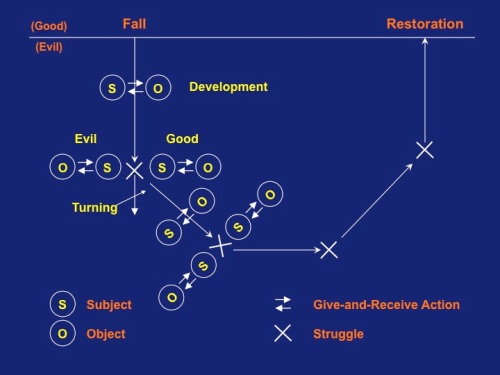Part II
 In my previous article I asked, “What would a world of perfect people be like? Is it desirable? Would you want to live in it? And is it even possible?” I discussed several possible reactions, and presented the Unification Thought (UT) viewpoint. However, I did not address the big issue of whether it is even possible. Yes, UT presents a positive picture of perfect human beings, but we all know the real world we live in is very far from that ideal.
In my previous article I asked, “What would a world of perfect people be like? Is it desirable? Would you want to live in it? And is it even possible?” I discussed several possible reactions, and presented the Unification Thought (UT) viewpoint. However, I did not address the big issue of whether it is even possible. Yes, UT presents a positive picture of perfect human beings, but we all know the real world we live in is very far from that ideal.
Why do we have difficulty believing such a world is possible? I think one of the reasons is because of our misunderstanding of what it means to be “perfect,” an issue that was addressed in my first article. Are any of the characteristics of original human nature described in that article impossible to achieve? They are difficult, but not inherently impossible.
Then it comes down to our effort, and overcoming what can be termed our fallen nature, or our tendency to take the easier way instead of challenging ourselves to greater heights in relating to others and in doing good toward others. For example, “I can’t imagine it really” can be translated into “I won’t ever be perfect because I have this and that imperfection which I don’t think I am going to overcome in the foreseeable future, and everyone else I know is like that too.”
Perhaps one way to make perfection seem more attainable is to remember that we don’t have to achieve it in one step. Even in the ideal, with no fallen nature to get in our way, human beings develop through three stages of growth, over a period of say 21 years, to reach maturity. So, it certainly makes sense that as fallen people who face not only the original growing up, in an environment that is far from supportive of the ideal, but also the restoration of all our mistakes and that nourished our fallen nature, we might expect it to take time and to go through a number of steps.
Figure 1
Here I am reminded of the diagram used to describe the “Law of Turning” in the Unification Thought theory of history (see Figure 1). This diagram illustrates how a united subject and object make progress in a particular direction that begins far from, even opposite to, the direction of goodness, but through a series of encounters with other subjects whose purpose and direction is closer to that of God’s, adjustments to the direction are made. Thus the direction of progress turns closer and closer toward being in alignment with goodness.
In my case, I can imagine that I am that being of united subject and object (an individual with mind and body united to accomplish a goal), but that my heart and purpose are still far from being in alignment with the true purpose of heaven. Yet, as I take action and make progress, I encounter others who are closer to the side of goodness, with their heart and purpose more closely aligned with God’s. This means that relatively speaking I am the subject of evil, at least as far as the diagram goes! When we meet there is conflict: I complain, I resist, but if I try really hard I digest the criticism and try to go in a new direction and change my path by at least a few degrees. Then I make progress again on that path for a while until a new encounter with greater goodness occurs.
From this diagram I understand two important points about making progress toward perfection. First, if I don’t act I don’t make any progress and so I won’t be able to have an encounter with someone who is more aligned with God’s viewpoint. As New York mayor, Michael Bloomberg, has said, “You don’t have to get it right, you just have to get it going.” In this case, when you’re moving along a path, even if the direction is not perfect, it opens possibilities to getting closer to perfection. Second, even if I kick and scream every time I meet someone who is closer to God’s viewpoint than I am, that initial resistance is OK. It means I felt challenged by this new viewpoint and want to adopt it, but I don’t know how. If I just ignore this new source of guidance and continue on my own path, I will never change. Change is difficult, especially change toward greater unselfishness. It’s not surprising if we get a bit upset when faced with the new direction; in fact, it shows that we are making the effort to understand and incorporate it into our lives.
It is easy to be discouraged when our attempts at behaving like perfect human beings meet with the selfish responses of others who are less than perfect. I had a high school friend whom I admired greatly because she always appeared friendly, kind, positive, and always giving to and taking care of others. She seemed a fine example to me and was well-liked by everyone. Imagine my shock when she announced one day, as we were getting close to graduation, that she was going to change after high school: she was going to take care of herself instead of always helping others. She had decided this based on her experiences with others. I have never forgotten her. And when I feel tempted to give up on others and just look out for myself, I remember how I thought her decision was wrong then and was sorry that she had thought she should abandon her genuine heart of living for the sake of others.
I encountered another example of resistance to perfection in M. Scott Peck’s In Heaven as on Earth: A Vision of the Afterlife. This takes the form of accusing someone (in this book the prophet Daniel) of being “too good to be true” when they appear to have only good qualities and no failings. In Peck’s book, however, the main character is told by one of his guides that the impatience he sees to be his weakness may in fact be the very quality of his that God wants to use. This reminded me of the chart in Essentials of Unification Thought showing Yang and Yin characteristics of human nature (reproduced as Figure 2). In that chart it is clear that not all aspects of human character are those we usually consider desirable. Forgetful, vague, sorrowful, and aggressive are not obviously positive traits. However, this chart tells us that without the ability to experience sorrow, forgetfulness, and aggression we would not be truly human. Again, perfection necessarily involves individuality and uniqueness. Thus, the quality of impatience, just as much as patience, is one that can be valued by God in perfect human beings.
Figure 2
It is up to us to strive to achieve all the attributes of original human nature, and teach those who don’t know them by sharing this understanding and, more importantly, by our example. Unlike my high school friend, we should not be discouraged by the fallen nature we encounter in other people, and ourselves, but continue to strive toward our own perfection, lending a hand to others until all human adults are perfect. I have no fear that a world of perfect people will be boring. Like a collection of old pictures that have become covered in dust and grime so that they all look the same, humankind will blossom and glow with incredible richness and excitement as we remove our fallen nature and attain perfection.♦
Dr. Jennifer P. Tanabe earned her Ph.D. in psychology from the University of Edinburgh. She has served on the faculty and in various administrative capacities at UTS, presently as an educational consultant for Outcomes Assessment. She is the author of The Ideal Family To Be or Not To Be: Testimonies of a Life Of Faith – A Biography of David S. C. Kim, and Contemplating Unification Thought, from which this article is adapted.




The elephant in the room. Did I miss reading your comments on original sin?